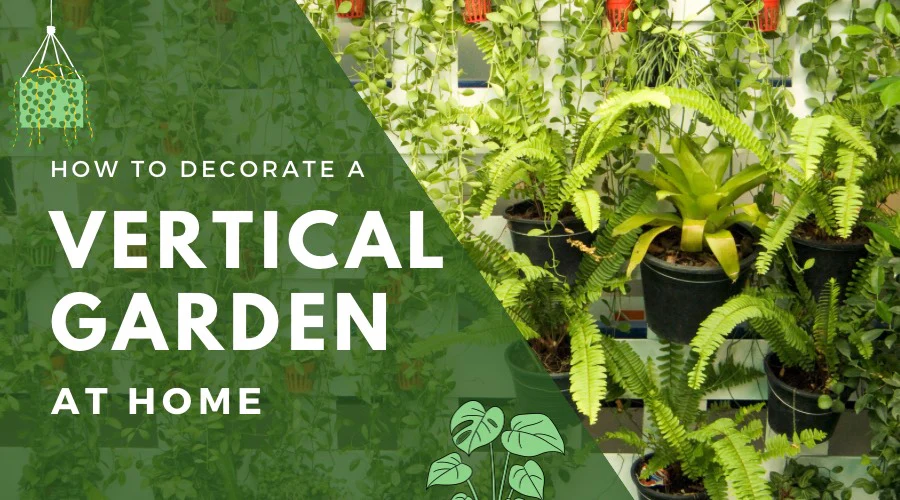Vertical gardening is an innovative and space-saving approach to growing plants indoors, especially in smaller apartments or homes. By utilizing vertical surfaces like walls, shelves, and other elevated spaces, you can create a lush, green oasis in even the tiniest of living spaces. Vertical gardening not only adds aesthetic appeal but also purifies the air, improves mood, and can provide you with fresh herbs, vegetables, and flowers.
In this blog, we will explore 10 potential walls and spaces inside your home where you can start vertical gardening. Whether you have a spacious living room or a cozy apartment, these ideas will help you turn any underutilized space into a green haven.

Living Room Walls
The living room is often the focal point of a home, and adding vertical gardens to the walls can transform the ambiance of the space. Whether you have a bare wall, an empty corner, or an uninteresting bookshelf, this area is a prime location to introduce plants. You can hang vertical planters, install wall-mounted shelves, or use modular plant panels to create a living art piece.
- How to Do It: You can use hanging planters with plants like pothos, ivy, or trailing vines. Another option is installing a vertical garden rack that allows you to grow smaller plants like succulents or herbs. Choose plants that don’t require direct sunlight, or place your vertical garden near a window to give your plants the light they need.
- Benefits: Besides improving aesthetics, plants in the living room can help purify the air and create a serene, calming environment. The greenery can also act as a natural divider between different areas of the living room.

Kitchen Walls for Herb Garden
The kitchen is an ideal space for a vertical garden, especially for growing culinary herbs like basil, thyme, rosemary, mint, and cilantro. Vertical gardens in the kitchen are space-efficient, and practical, and add a delightful touch to your cooking space. Having fresh herbs on hand while cooking is both convenient and rewarding.
- How to Do It: You can install a wall-mounted herb garden next to your cooking station, or even transform the space above your kitchen counter into a plant wall. Vertical plant towers or small shelves can be placed by the window, where the plants will get adequate sunlight.
- Benefits: A kitchen herb garden will provide fresh herbs for your meals and is a beautiful addition to your kitchen decor. It can also help with air purification and bring a refreshing fragrance to your cooking area.

Balcony or Patio Walls
If you have access to a balcony or a patio, you have a great opportunity to turn the walls into a vertical garden. This is the perfect space to grow flowering plants, climbing vines, or even small vegetables. Since balconies often receive ample natural light, plants here can thrive, especially those that require full sun.
- How to Do It: Install vertical garden panels or trellises against the walls to support climbing plants like tomatoes, peas, cucumbers, or even flowering vines like morning glories. If space is limited, you can also use wall-mounted planters or hanging baskets to maximize the vertical space.
- Benefits: Growing a vertical garden on your balcony or patio not only provides an aesthetic enhancement but also creates a private oasis where you can relax amidst nature. It can also shield you from the sun, offering a more comfortable outdoor living space.

Bedroom Walls for Indoor Greenery
The bedroom is a perfect place to add some tranquility with vertical gardening. By adding plants to your bedroom walls, you can create a calm, peaceful environment that promotes relaxation and good sleep. Plants like succulents, air plants, and snake plants are great for this space because they require minimal light and care.
- How to Do It: Use floating shelves or wall-mounted plant holders to add plants without occupying floor space. For a more dramatic effect, consider installing a vertical garden panel with a variety of low-maintenance plants. Hanging plants can also work well in bedrooms with limited space.
- Benefits: The bedroom is the perfect environment for indoor plants because they improve air quality and add to the overall ambiance. Additionally, indoor plants like lavender or jasmine can help reduce stress and improve sleep quality.

Staircase Walls
If your home has stairs, the wall next to the staircase is a fantastic place to start a vertical garden. This often overlooked space can be transformed into a unique, stylish, and green feature of your home. Using the space beside your staircase can help optimize the use of vertical areas that otherwise go unused.
- How to Do It: Install vertical planters or hanging pots along the wall next to the staircase. You could also create a series of wall-mounted shelves for plants. Ensure the plants are suited for low to medium light conditions since staircases might not always have direct access to sunlight.
- Benefits: Vertical gardens along the staircase will make the space more inviting, and the plants can make the passage between floors more lively. The visual appeal of the plants can also create a more cohesive design throughout your home.

Bathroom Walls for Low-Light Plants
Bathrooms are often considered a challenging space to incorporate plants due to limited light and humidity. However, bathrooms with windows or those that are relatively well-lit can be transformed into vertical gardens. The high humidity in bathrooms can be ideal for moisture-loving plants like ferns and moss, which thrive in these conditions.
- How to Do It: Hang small potted plants, use wall-mounted planters, or install a vertical wall garden with air plants, pothos, ferns, and other plants that thrive in humidity. For bathrooms with limited light, choose plants that require low light, like peace lilies or spider plants.
- Benefits: Vertical gardens in the bathroom will not only enhance its aesthetics but also improve air quality and humidity control. Plants like ferns, bamboo, and aloe vera are particularly great in bathrooms due to their air-purifying properties.

Entryway Walls
The entryway is the first place your guests see when they enter your home. By creating a vertical garden in this area, you can make a stunning first impression. A green, inviting entrance sets a positive tone for your home, and incorporating plants can add a fresh, natural feel to your interior.
- How to Do It: Consider installing a vertical garden rack or wall planters along the entryway wall. Choose plants that are easy to maintain and don’t require too much attention, as the entryway is a high-traffic area. Small plants, succulents, or hanging baskets can work beautifully.
- Benefits: A vertical garden in the entryway enhances the visual appeal of your home while creating a warm and welcoming atmosphere. Additionally, plants in the entryway can improve indoor air quality, making it a healthier space to enter.

Laundry Room Walls
The laundry room is one space in the home that often gets neglected when it comes to decoration. However, it’s a great place to implement vertical gardening, especially if you want to add a touch of nature to a functional space. Plants can thrive in laundry rooms due to the humidity from washing machines and dryers.
- How to Do It: Use wall-mounted shelves or vertical planters to add greenery to the walls. Consider plants that do well with humidity, such as ferns or pothos, which can handle the moisture and heat from the laundry room environment.
- Benefits: Adding plants to the laundry room can enhance the atmosphere by making the space feel less utilitarian and more inviting. Additionally, plants can help improve air quality in enclosed spaces like laundry rooms.

Home Office Walls
Working from home has become increasingly popular, and what better way to improve productivity than by adding plants to your home office? Vertical gardening in your office can add a touch of nature, which has been shown to boost creativity, reduce stress, and improve overall focus.
- How to Do It: Install floating shelves or a vertical garden panel to display low-maintenance plants like succulents, snake plants, or air plants. You could also place a vertical plant rack on a wall next to your desk, allowing you to have easy access to plants without cluttering your workspace.
- Benefits: Plants in your home office can create a calming and focused environment, helping to reduce anxiety and increase work productivity. The greenery can also enhance the visual appeal of your workspace, making it more comfortable and pleasant.

Hallway Walls
Hallways are often narrow, underused spaces in a home, but they offer a unique opportunity for vertical gardening. A vertical garden in the hallway can create a green, welcoming atmosphere and help bring life to otherwise dull, empty spaces.
- How to Do It: You can install wall-mounted shelves or vertical planters along the hallway walls. Hanging planters and plant racks are also great options for making use of this vertical space. Choose plants that don’t require too much sunlight and can thrive in low-light conditions.
- Benefits: Adding plants to the hallway will give the space a vibrant, lively feel and contribute to overall home decor. Plants in the hallway can also improve air quality and create a sense of tranquility as you move through the space.

Conclusion
Vertical gardening offers a fantastic way to utilize otherwise unused spaces in your home, whether you live in a small apartment or a spacious house. From the kitchen to the bedroom, balcony, or hallway, there are numerous walls and spaces where you can start growing your indoor garden. Vertical gardens not only improve the aesthetics of your home but also provide health benefits, such as air purification, stress reduction, and a more peaceful ambiance.
No matter where you choose to start, the possibilities are endless with vertical gardening. It’s time to start thinking vertically and transform your home into a lush, green sanctuary!





